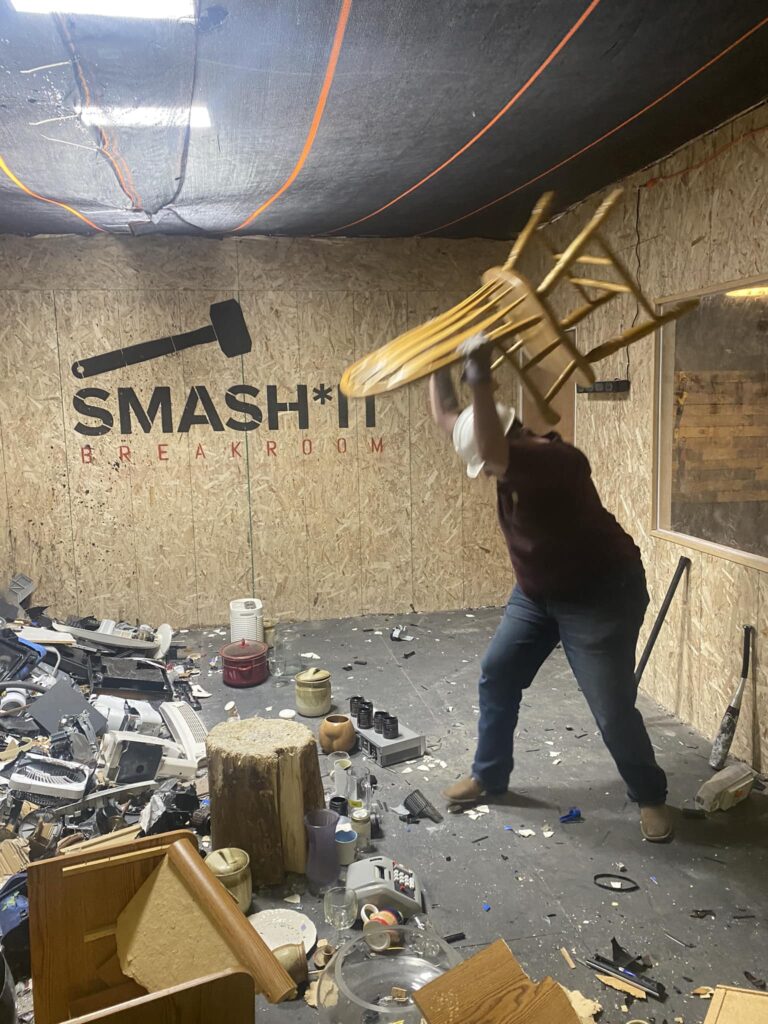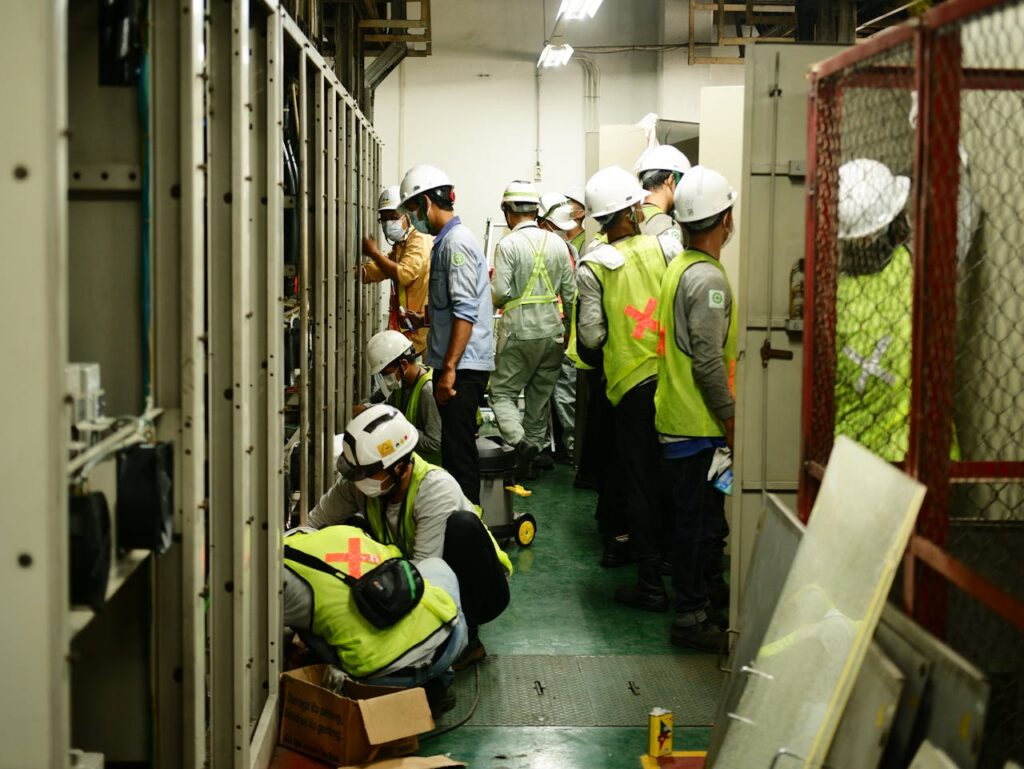Ever felt so overwhelmed or stressed that the only thing you could think of doing was smashing something? Enter smash therapy – the unconventional remedy for pent-up frustration.
Smash therapy is an innovative approach to stress relief that involves shattering objects with a variety of blunt instruments, such as sledgehammers and baseball bats, to help you release built-up anger and tension.
This unique therapy takes place in specially designed environments known as rage rooms or destruction rooms, where the goal is to let go of your stress and enhance your mental well-being.
But is smash therapy really effective? And what should you expect from your sessions? Let’s delve into the details.
What is Smash Therapy?
Smash therapy is a form of emotional release therapy where participants break items like glass, furniture, or electronics to alleviate their emotions. The fundamental concept is that by physically demolishing objects, you can experience a cathartic release, which in turn helps to lower stress levels. It also offers a way to manage anxiety and address feelings of anger or rage.

Definition
Often referred to as rage therapy, anger room therapy, or destruction therapy, smash therapy involves a session where you’re equipped with safety gear like goggles and gloves. You’ll have the chance to break objects using various tools, including sledgehammers, baseball bats, and crowbars.
The items you get to destroy may be chosen based on your preferences or may be pre-selected by the therapist.
History
Smash therapy is a relatively recent innovation that has gained traction globally. Its roots can be traced back to Japan in the early 2000s, where it was known as “katahara itaku” or “rent-a-wreck room.”

This concept was designed to provide a secure space for individuals to vent their emotions and frustrations without causing harm to themselves or others. Since then, smash therapy has expanded to other countries, including the United States, where it has become a popular method for stress relief.
Benefits of Smash Therapy
Feeling bogged down or stressed out? Smash therapy might be just the outlet you need. Here’s a look at the benefits this unique therapy can offer:
Physical Benefits
Engaging in smash therapy is an excellent way to get physical exercise and expel energy. Wielding a sledgehammer or another tool to destroy objects involves using your muscles and elevates your heart rate, which can help alleviate tension and anxiety.
This physical activity not only makes you feel more relaxed but also revitalizes your energy levels.
Mental Benefits
One of the key advantages of smash therapy is its ability to provide a safe and controlled environment to explore your emotions. When smashing objects, you have an opportunity to express feelings of anger, frustration, and other emotions in a non-destructive manner. This can be an effective way to release pent-up aggression and regain a sense of control over your emotions.
Additionally, smash therapy offers a means to reduce stress and anxiety. Focusing on the act of breaking things can shift your attention away from your daily worries, helping you feel more relaxed and improving your overall mood.

It can also bolster self-confidence and self-esteem. By experiencing a sense of control and empowerment during your sessions, you might feel more capable of handling challenging situations in your life.
In summary, smash therapy provides a physical and emotional outlet for those struggling with stress and frustration. Whether you’re looking to relieve tension, gain a new perspective, or simply enjoy the thrill of destruction, smash therapy might be the perfect fit for your stress-relief routine.
Does Smash Therapy Work?
While smash therapy can offer a temporary release of tension and provide a cathartic experience, its effectiveness as a long-term solution for managing anger and stress is not strongly supported by scientific evidence.
The primary benefit of smash therapy lies in its ability to offer immediate relief by allowing individuals to physically express their frustrations. However, it does not tackle the underlying causes of these emotions.
For sustainable management of anger and stress, mental health professionals advocate a more comprehensive approach. This often includes traditional talking therapies, mindfulness practices, and various stress management techniques.
Cognitive Behavioral Therapy (CBT), for example, is a widely accepted method that assists individuals in identifying and altering negative thought patterns and behaviors contributing to their stress and anger.
Mindfulness practices, such as meditation and deep breathing exercises, are also recommended. These techniques help individuals cultivate greater awareness of their emotional states and manage them more effectively.
Additionally, adopting healthy lifestyle habits, including regular exercise, balanced nutrition, and sufficient sleep, can play a significant role in reducing stress and enhancing overall well-being.

It’s also crucial to recognize that smash therapy might not be appropriate for everyone. Individuals with a history of trauma or violence may find the experience triggering or retraumatizing. Furthermore, relying on physical destruction to manage emotions might reinforce negative behaviors and potentially lead to further issues.
In summary, while smash therapy can provide short-term relief from stress and anger, it is not a substitute for addressing the root causes of these emotions. A holistic approach that combines therapy, mindfulness, and stress management techniques is recommended for long-term emotional health.
Who is Smash Therapy Good For?
Smash therapy can be advantageous for various individuals, particularly those who:
- Experience high levels of stress or anxiety and require a physical outlet to relieve tension.
- Struggle with managing anger or have difficulty expressing emotions in a healthy manner.
- Are undergoing significant life transitions, such as a breakup or job loss, and need a way to process their feelings.
- Have experienced trauma or abuse and need a safe method to release associated emotions.
- Are seeking a unique and enjoyable way to alleviate stress and improve their overall well-being.

Age Requirements for Smash Therapy
Smash therapy is generally suitable for individuals of various ages. However, age restrictions often apply at smash therapy facilities.
Many rage rooms set a minimum age requirement of 18 years old. Conversely, some facilities might offer sessions for children as young as six years old, provided they are accompanied by a parent or guardian.
To ensure compliance with specific guidelines, it’s advisable to check with your local rage room or smash therapy provider regarding their age policies.

How Smash Therapy Works
The Process
The process of smash therapy is straightforward:
- Enter the Room: You step into a designated area filled with items meant for destruction, such as glass bottles, old electronics, or furniture.
- Gear Up: You receive protective gear, including gloves and goggles, to ensure safety during the session.
- Choose Your Weapon: You are given a tool, like a baseball bat or sledgehammer, to begin the smashing.
- Release Emotions: You are encouraged to let out your negative emotions by breaking as many items as you wish.
- Session Duration: Typically, sessions last around 30 minutes, but this can vary depending on the provider.
Overall, smash therapy provides a unique outlet for stress relief but should be complemented with other therapeutic practices for a more holistic approach to emotional health.

What to Expect
Before your smash therapy session begins, there are a few preliminary steps you should be aware of. You’ll need to sign a waiver and participate in a safety briefing to ensure you’re fully prepared. It’s also advisable to wear comfortable clothing and closed-toe shoes for your session.
During the session, you can anticipate experiencing a profound sense of relief and release as you break various items. Many people report feeling a surge of empowerment and control, as smashing objects allows them to channel their frustrations in a productive way.
After the session, you might notice a notable boost in your mood, coupled with a sense of calm and relaxation.
Safety and Precautions
Safety Measures
While smash therapy can be a thrilling and effective way to alleviate stress, safety is paramount. To avoid accidents or injuries, make sure to follow these safety protocols:
- Wear Protective Gear: Always don closed-toe shoes, along with any additional protective equipment provided, such as helmets and gloves. These items help shield you from flying debris.
- Controlled Environment: Smash rooms are designed to contain debris, ensuring that it remains within the room and does not pose a risk to others. Observers can safely watch the session via a monitor positioned outside the room.
- Follow Instructions: Adhere closely to the facilitator’s guidelines. Avoid directing your swings or throwing objects towards other participants. If sharing the space, exercise caution to prevent accidents and ensure everyone’s safety.

Precautions
Although smash therapy can be beneficial, it is not universally suitable. Consider the following precautions:
- Mental Health Conditions: Individuals with certain mental health disorders, such as bipolar disorder or schizophrenia, might find the experience overwhelming or triggering. Consulting with a mental health professional beforehand is crucial to determine if smash therapy is appropriate for you.
- Physical Limitations: Those with physical limitations or injuries should avoid smash therapy, as the physical activity involved may exacerbate existing conditions. Pregnant women should also steer clear of smash therapy due to the potential risk of injury to themselves or the fetus.
- Consult a Professional: Prior to engaging in smash therapy, it’s advisable to consult with a healthcare provider to confirm that it is a safe and suitable option for you.
Conclusion
Smash therapy offers a distinctive approach to stress relief, gaining popularity for its immediate impact on emotional release. Although scientific evidence supporting its long-term effectiveness is limited, many participants report feeling more at ease after their sessions. If you’re considering trying smash therapy, thorough research is essential to find a reputable provider.
However, remember that smash therapy should not replace professional mental health treatment. If you’re facing significant mental health challenges, seeking help from a licensed therapist or counselor is crucial. Smash therapy can serve as a valuable supplement to traditional therapies but should not be relied upon as the sole method of treatment.
Moreover, keep in mind that smash therapy can be a costly endeavor. If budget constraints are a concern, explore other cost-effective stress management options like exercise, meditation, or spending time in nature. Ultimately, the most effective stress relief method is the one that aligns best with your individual needs and circumstances.
